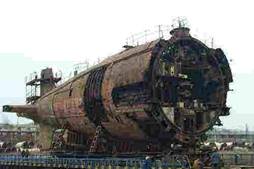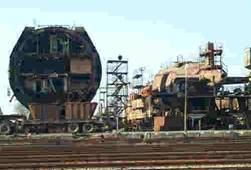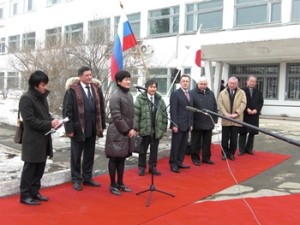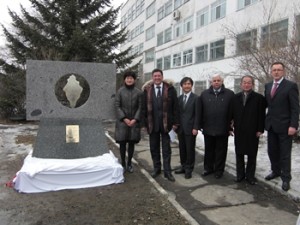- Summary
(1) The Japan-Russia Committee assisted in the dismantlement of Russian decommissioned nuclear submarines in the Far East in the light of nuclear disarmament and non-proliferation and the environmental protection of the Sea of Japan (“Star of Hope” program).
(2) The cooperation in dismantling Russian retired nuclear submarines was a key pillar of the “Japan-Russia Action Plan” (2003) and also designated as one of the priority areas of the G8 Global Partnership against the Spread of Weapons and Materials of Mass Destruction (2002).
(3) Under the Star of Hope, the following six decommissioned submarines were dismantled. For the dismantling works, the Government of Japan allocated 4.92 billion JPY, while other G8GP participants (Australia, Republic of Korea and New Zealand) provided financial assistance amounting to 880 million JPY.
(A) Victor-III class (hull No. 304)
(B) Victor-I class (hull No. 614)
(C) Charlie-I class (hull No.714)
(D) Victor-III class (hull No.333)
(E) Victor-III class (hull No.271)
(F) Victor-III class (hull No.308)
(4) The program started in June 2003 and successfully completed in December 2009
- Background
(1) After the end of the Cold War, a large number of Russian nuclear submarines were decommissioned and moored in the North West and Far East of Russia. The dismantlement was however delayed due to the socioeconomic turmoil in Russia following the collapse of the Soviet Union.
(2) The decommissioned submarines with spent nuclear fuel (SNF) on board were considered vulnerable to intrusion and nuclear material theft. They also posed a potential threat of radioactive contamination due to the hull corrosion.
(3) It was therefore important not only for Russia but also for the international community to expedite nuclear submarine dismantlement in a safe manner.
(4) In May 1999 the Japanese Government announced the “Japan-Russia Joint Operational Project for Disarmament and Environmental Protection (the Japanese Government’s Support for Russia’s Denuclearization and a New Initiative in the Area of Disarmament and Nonproliferation of Nuclear Weapons).” Within the frameworks of this Initiative, it was decided to cooperate in the dismantlement of decommissioned nuclear submarines in Russian Far East with recognition that it is an essential and urgent issue in arms control, disarmament and environmental protection of the Sea of Japan.
(5) At the Kananaskis Summit in June 2002, the leaders agreed to launch the “G8 Global Partnership against the Spread of Weapons and Materials of Mass Destruction”, which specified the dismantlement of retired nuclear submarines as one of the priority areas.
- Project Sites
– Zvezda Shipyard (Bolshoy Kamen, Primorsky region, Russian Federation)
– North Eastern Repair Centre (Vilyuchinsk, Kamchatka region, Russian Federation)
- Russian Counterparts
-Rosatom, DalRAO, Zvezda Shipyard and North Eastern Repair Centre
- Dismantlement Process
The dismantlement process includes the following steps. A decommissioned submarine is towed to the shipyard, and the spent nuclear fuel is removed from the reactors and sent to the storage (These works were covered by Russian budget.). The hull is then cut into three sections. While the bow and stern sections are scrapped,. The middle section containing the defueled reactor is sealed, re-launched and towed to a temporary storage facility.
(1) Dismantlement of Victor-III class (No. 304) nuclear submarine (Pilot project)
In June 2003, during the Foreign Minister Yoriko Kawaguchi’s visit to Vladivostok, the Implementing Arrangement for dismantlement of one Victor-III class nuclear submarine (pilot project under the Star of Hope) was signed.
| Implementing Arrangement: | June 2003 |
| Financing Contract: | December 2003 |
| Project Completion: | December 2004 |
| Implementing organization: | Zvezda Shipyard |
| Funds disbursed: | 794 million JPY |
| Financed by: | Japan |
 |
 |
| Dismantlement of Victor-III class nuclear submarine (Pilot project) | |
(2) Dismantlement of Five submarines
On the occasion of the Russian President Vladimir Putin’s visit to Japan in November 2005, the Japan-Russia Committee signed the new Implementing Arrangement with the Russian Federal Agency for Atomic Energy on dismantling additional five decommissioned nuclear submarines. The arrangement covered one Victor-I class, three Victor-III class and one Charlie-I class nuclear submarines.
(A) Dismantlement of Victor-I class (No. 614)
| Implementing Arrangement: | November 2005 |
| Financing Contract: | September 2006 |
| Project Completion: | November 2008 |
| Implementing organization: | Zvezda Shipyard |
| Funds disbursed: | 870 million JPY |
| Financed by: | Japan, Australia, Republic of Korea |
(B) Dismantlement of Charlie-I class (No.714)
| Implementing Arrangement: | November 2005 |
| Financing Contract: | January 2008 |
| Project Completion: | April 2009 |
| Implementing organization: | North Eastern Repair Centre |
| Funds disbursed: | 944 million JPY |
| Financed by: | Japan |
(C) Dismantlement of Victor-III class (Nos.271, 308 and 333)
| Implementing Arrangement: | November 2005 |
| Financing Contract: | August 2007 |
| Project Completion: | December 2009 |
| Implementing organization: | Zvezda Shipyard |
| Funds disbursed: | 3,193 million JPY |
| Financed by: | Japan, Republic of Korea, New Zealand |
- Financial Support to “Star of Hope” from Global Partnership Partners
| Country | Contribution | Amount |
| Australia | June 2004 | 742 million JPY |
| Republic of Korea | December 2006 | 29.5 million JPY |
| Republic of Korea | December 2007 | 28.3 million JPY |
| New Zealand | July 2008 | 55.1 million JPY |
| Republic of Korea | December 2008 | 22.0 million JPY |
- Completion Ceremony
On March 20, 2010, the closing ceremony of Star of Hope program was held at the Zvezda Shipyard. The Japanese side was represented by Ms. Chinami Nishimura, Parliamentary Vice-Minister for Foreign Affairs.During the ceremony, gratitude for Japanese cooperation was expressed by Russian stakeholders, and a stone monument was unveiled to commemorate the completion of the program.
 |
 |
| Completion ceremony | |